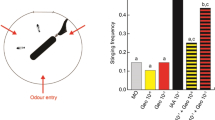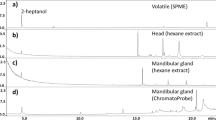Abstract.
In the honeybee, isopentyl acetate and 2-heptanone are described as alarm substances. We asked whether both substances have a similar role by testing the effect of their exposure on the appetitive proboscis extension reflex and on the aversive stinging reflex. In the appetitive context of sucrose stimulation no differences were found between isopentyl acetate and 2-heptanone. Small amounts of isopentyl acetate or 2-heptanone (3 µl of 1:9 dilution) yielded a response similar to that of a non-exposed control. Larger amounts of both substances (125 µl of 1:9 dilutions) as well as mixtures led to a decrease of responsiveness to sucrose. In the aversive context of electrical stimulation, significant differences between isopentyl acetate and 2-heptanone were found. Exposure to a small amount of isopentyl acetate (3 µl of 1:9 dilution) or to a large amount of 2-heptanone (125 µl of 1:9 dilution) led to an increase of responsiveness to the electric shock. Larger quantities of isopentyl acetate (125 µl of 1:9 dilution) decreased the responsiveness to the shock. 2-Heptanone never decreased the responsiveness to the shock. Our results indicate that isopentyl acetate and 2-heptanone have different functions even if both are capable of evoking deterrent responses in a defensive context.
Similar content being viewed by others
Author information
Authors and Affiliations
Additional information
Electronic Publication
Rights and permissions
About this article
Cite this article
Balderrama, .N., Núñez, .J., Guerrieri, .F. et al. Different functions of two alarm substances in the honeybee. J Comp Physiol A 188, 485–491 (2002). https://doi.org/10.1007/s00359-002-0321-y
Accepted:
Issue Date:
DOI: https://doi.org/10.1007/s00359-002-0321-y




